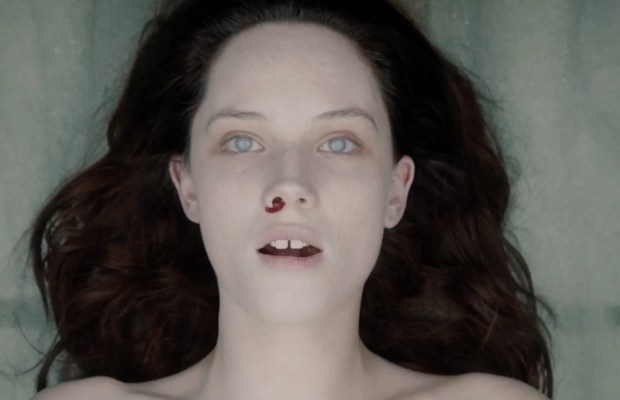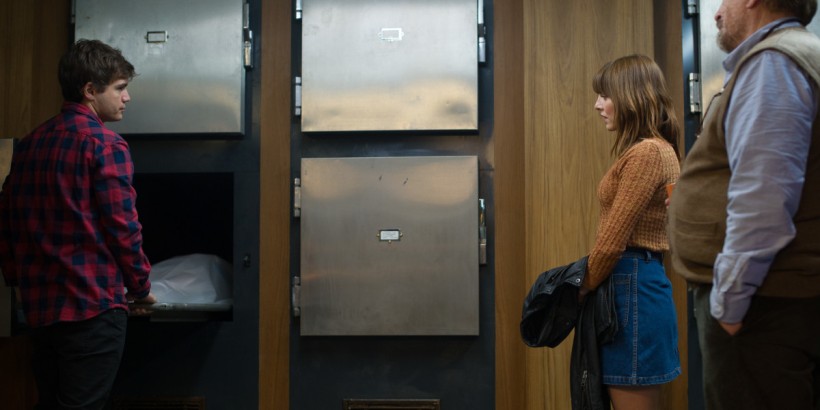W filmie Andre Øvredala straszy atmosfera, zaś zagadka wokół której dwójka głównych bohaterów krąży, pozostaje niewyjaśniona do samego końca. I dzięki solidnie zaplanowanemu scenariuszowi oraz sprawnemu wykonaniu, horror Norwega ogląda się nie tylko z wypiekami na twarzy, ale przede wszystkim nieskrywaną przyjemnością.
Bohaterami Autosji Jane Doe są ojciec i syn (Brian Cox i Emile Hirsch), którzy prowadzą prywatny zakład patologiczny. Gdy pewnej nocy praca zbliża się u końcowi, mężczyźni niespodziewanie otrzymują jeszcze jedno zlecenie. Jednak gdy tylko rozpoczynają sekcję zwłok niezidentyfikowanej kobiety, ich zakład powoli zamienia się w istne piekło.
André Øvredal, reżyser Autopsji Jane Doe, z pietyzmem przygotowuje widza na horrorowe fajerwerki, które ma w zanadrzu. Pierwsze pół godziny poświęca na zbudowanie atmosfery, pieczołowicie przyglądając się wysiłkom duetu patologów. Jednak nawet pomimo wszechobecnego, specjalistycznego języka medycznego, jego instruktaż krojenia ciał i wyjmowania zeń wnętrzności ogląda się jak w hipnozie. Kredowa biel oraz upiorne, zamglone oczy Jane Doe zwiastują nadejście sił nadprzyrodzonych, ale widz zmuszony jest siedzieć jak na szpilkach, bowiem najgorsze dopiero przed nami.

Poniekąd, Autopsja Jane Doe przypomina francuskie dzieło Eyes Without A Face z 1960 roku – wygrywa w starciu z większością horrorów dzięki unikaniu oczywistości i swoistym uwielbieniu detalu. Zdarzają się skrzypiące drzwi, ale nigdy nie wejdą na pierwszy plan. Gdy już się pojawią, są tłem, rozpraszającym widza oraz głównych bohaterów z patologicznej hipnozy. Dzięki temu zdrowemu rozsądkowi, Øvredal swobodnie wpływa na coraz bardziej nieprawdopodobne tory w swojej historii. Zachowuje przy tym odpowiednie tempo, a co najważniejsze – logikę w zachowaniu swoich bohaterów. Nawet, gdy dwójka bohaterów popada w coraz większą paranoję związaną z powodem nocnej zmiany, ich chłodny racjonalizm zaskakuje. To nie typowe mięso armatnie, które Leatherface kroiłby piłą mechaniczną. To postaci z krwi i kości, którym chce się kibicować.
Tym bardziej doceniam Autopsję Jane Doe, im więcej daremnych horrorów przypomnę sobie z minionego roku. Gatunek, który cierpi na zarazę wtórności i brak talentu pośród osób go tworzących, potrzebuje dzieł takich jak film Øvredala. Niespiesznie przerażających, niezobowiązująco wciągających, ale przede wszystkim – kreatywnych.
Ocena: 35/50
Andre Øvredal’s film scares with its creepy atmosphere, whilst the mystery around the titular Jane Doe is getting more and more foggy and compelling. However, thanks to the top-notch script and agile execution, The Autopsy of Jane Doe is not only a frightening treat, but also a very entertaining one.
The Autopsy of Jane Doe tells the story of two pathologists – a son and his father (Emile Hirsch and Brian Cox respectively) – who work in their family business. One night, just about the time when both should end the shift, a body arrives for inspection. Once they begin the autopsy, some strange things begin to happen.
André Øvredal, the director of The Autopsy of Jane Doe, takes his time to prepare his audience for the “fireworks”. The first half an hour is devoted to a slow-burnt atmosphere-building process, which allows the viewer to get acquainted with the ins and outs of the family’s job. Even though it’s packed with very specialized, medical language, Øvredal’s guide on how to cut bodies and remove organs is a kind of hypnotizing, detailed trip. The pale white body and haunting eyes of Jane Doe are an omen of paranormal powers to come, but we are not rushing with anything in this film – preparation for the worst takes time.

One may see that The Autopsy of Jane Doe is similar to a French masterpiece Eyes Without A Face from 1960. It basically avoids the obvious things, at the same time praising the art of detailed scares. If we hear screeching doors, they are only a distraction for both the protagonists and the audience, who apparently melt in the hypnotic narration. André Øvredal skillfully moves his story to a spine-chilling experience, but he doesn’t get chaotic – it’s all kept in a logical order and with the right pacing. Even when his characters are driven by an overwhelming paranoia, they are not the ridiculous cannon fodder as it usually happens in horrors. Therefore, they wouldn’t be an easy task for Leatherface – they use their brains.
The more idle horrors I watch, the more I appreciate the ones like The Autopsy of Jane Doe. The genre that suffers from the plague of imitativeness and lack of talent among those involved in creation, desperately needs film like Øvredal’s one – terrifying, but not hasted, entertaining without being tiring, but most of all – creative.
UMP Grade: 35/50
